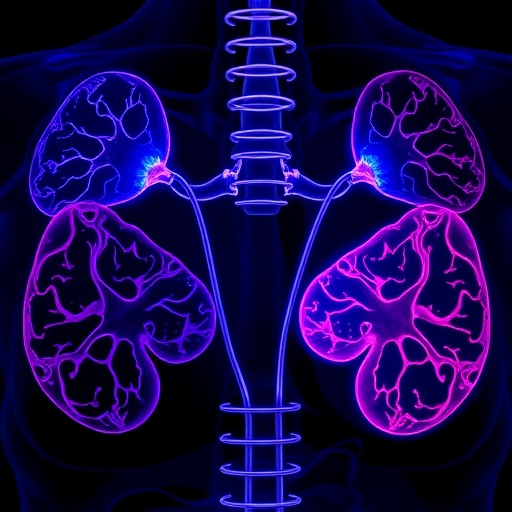In recent advancements in cancer research, significant attention has been focused on the intricate relationship between NKX3.1 and AURKA, especially in the context of castration-resistant prostate cancer (CRPC) and neuroendocrine prostate cancer (NEPC) models. Within the broader landscape of oncological studies, understanding these molecular interactions is proving crucial, not just for therapeutic advancements but also for unraveling the complex biology underlying these aggressive forms of prostate cancer. The correction brought forth by Sooreshjani, Kamra, and Zoubeidi highlights critical insights into how these pathways interplay in the progression of prostate cancer, providing a renewed perspective that challenges existing paradigms.
NKX3.1, a homeobox gene primarily expressed in prostate tissue, is instrumental in regulating prostate development and function. Its expression has been noted to diminish in the presence of prostate cancer, particularly in advanced stages. This reduction suggests that NKX3.1 is not only a tumor suppressor but also a vital player in maintaining normal prostate cellular physiology. The work published in the Journal of Biomedical Science acts as a vital reminder of the gene’s importance and the repercussions of its dysregulation amidst cancerous transformations.
Conversely, AURKA, or Aurora kinase A, is an oncogenic protein that has gained respect in cancer biology for its role in mitotic regulation. This kinase orchestrates various processes during cell division, ensuring proper chromosome segregation and cellular proliferation. In prostate cancer, particularly in its castration-resistant form, AURKA is often overexpressed, propelling cancer cells towards increased proliferation and survival despite therapeutic interventions designed to lower androgen levels. Understanding the elevation of AURKA in the absence of NKX3.1 presents a complex signaling dynamic critical for targeted cancer therapies.
The interplay between NKX3.1 and AURKA offers a compelling narrative on the balance between tumor suppressor functions and oncogene expression in prostate cancer biology. The correction highlighted by Sooreshjani et al. draws attention to how the reciprocal deregulation of these two entities signifies more than just a loss of control; it reflects a critical adaptive response of cancer cells to their environment. Such insights could pave the way for innovative treatment strategies that seek to recalibrate these pathways, potentially returning malignant cells to a more normal state of regulation.
Delving deeper into the mechanisms at work, it becomes apparent that the loss of NKX3.1 expression facilitates the gain of oncogenic characteristics in prostate cancer cells. The downregulation of this tumor suppressor correlates with phenotypic shifts towards more aggressive, neuroendocrine-type carcinomas. This transition is characterized by changes in cell adhesion, migration, and invasive potential, resulting in more aggressive cancer phenotypes that are notoriously challenging to treat. The subsequent upregulation of AURKA in this context is emblematic of a malignant adaptation, underscoring the need for a comprehensive understanding of these molecular shifts.
The research team emphasizes the importance of exploring therapeutic avenues that aim to restore NKX3.1 function or inhibit AURKA activity as dual strategies to combat the evolution of castration-resistant disease. For example, small-molecule inhibitors targeting AURKA have already entered clinical evaluations; however, understanding their effectiveness in the backdrop of altered NKX3.1 expression remains a critical area for further investigation. If restoring the balance between these molecules can effectively attenuate aggressive phenotypes, there may be grounds for a new paradigm in treating advanced prostate cancer.
The implications of these findings extend beyond immediate therapeutic strategies and hint at a broader re-examination of cancer biology principles. As scientists grapple with the increasing complexity of cancer genetics and epigenetics, the discovery of reciprocal interactions between tumor suppressors and oncogenes brings forth the need to rethink treatment frameworks that have traditionally focused on single molecular targets. The bi-directional influences between NKX3.1 and AURKA serve as a reminder that cancer does not merely alter one pathway; it orchestrates changes within an entire network of signaling cascades.
Furthermore, the corrections highlighted in this research provide an opportune moment for the scientific community to re-evaluate existing models of prostate cancer progression. As therapies increasingly lean towards personalized medicine, the understanding of molecular deregulation in individual tumors could yield tailored interventions that are more effective compared to conventional approaches. The dual targeting of both NKX3.1 and AURKA could define a new treatment schema that embraces the multifaceted nature of cancer biology.
In summary, the work conducted by Sooreshjani et al. not only reaffirms the critical roles of NKX3.1 and AURKA in prostate cancer but also opens avenues for future research that could reshape therapeutic strategies aimed at these two pivotal players. As the landscape of prostate cancer research evolves, the integration of findings like these will undoubtedly contribute to more refined and effective treatment protocols aimed at improving patient outcomes. The importance of collaborative efforts and multidisciplinary approaches in cancer research cannot be overstated, as it is through such collective insights that we inch closer to transformative breakthroughs in cancer therapy.
In conclusion, the reciprocal deregulation of NKX3.1 and AURKA exemplifies the dynamic interplay of tumor suppressor and oncogene activities in prostate cancer progression, highlighting the complexity that characterizes malignancies. Continued research into these interactions is essential, not only for academic curiosity but for developing the next generation of cancer therapies that could ultimately save lives. As we move forward, insights gleaned from studies such as these will be crucial to illuminating the path toward effective treatment modalities that account for the multifaceted nature of cancer.
The research presented serves as a vital reminder that new paradigms in cancer treatment are continuously emerging, driven by innovative discoveries and corrections that refine our understanding of the intricate biological processes at play. Keeping a close watch on such developments is essential for both researchers and clinicians, as they could very well determine the future directions of cancer care in the near future.
In the race against cancer, knowledge is power, and it is the ongoing commitment to elucidating the depths of oncogenesis that will ultimately equip us with the tools necessary to orchestrate a more effective battle against this formidable adversary.
Subject of Research: Reciprocal deregulation of NKX3.1 and AURKA in castration-resistant prostate cancer and NEPC models.
Article Title: Correction: Reciprocal deregulation of NKX3.1 and AURKA axis in castration-resistant prostate cancer and NEPC models.
Article References:
Sooreshjani, M.A., Kamra, M., Zoubeidi, A. et al. Correction: Reciprocal deregulation of NKX3.1 and AURKA axis in castration-resistant prostate cancer and NEPC models.
J Biomed Sci 32, 100 (2025). https://doi.org/10.1186/s12929-025-01189-9
Image Credits: AI Generated
DOI: 10.1186/s12929-025-01189-9
Keywords: NKX3.1, AURKA, castration-resistant prostate cancer, neuroendocrine prostate cancer, molecular interactions, tumor suppressors, oncogenes, therapeutic strategies, cancer research.
Tags: advanced prostate cancer researchAURKA role in cancer progressioncastration-resistant prostate cancer mechanismsdysregulation of NKX3.1 and AURKAinsights from Journal of Biomedical Sciencemolecular interactions in oncological studiesneuroendocrine prostate cancer insightsNKX3.1 function in prostate canceroncogenic proteins in prostate cancerprostate cancer biology and treatmenttherapeutic advancements in prostate cancertumor suppressor genes in prostate cancer





